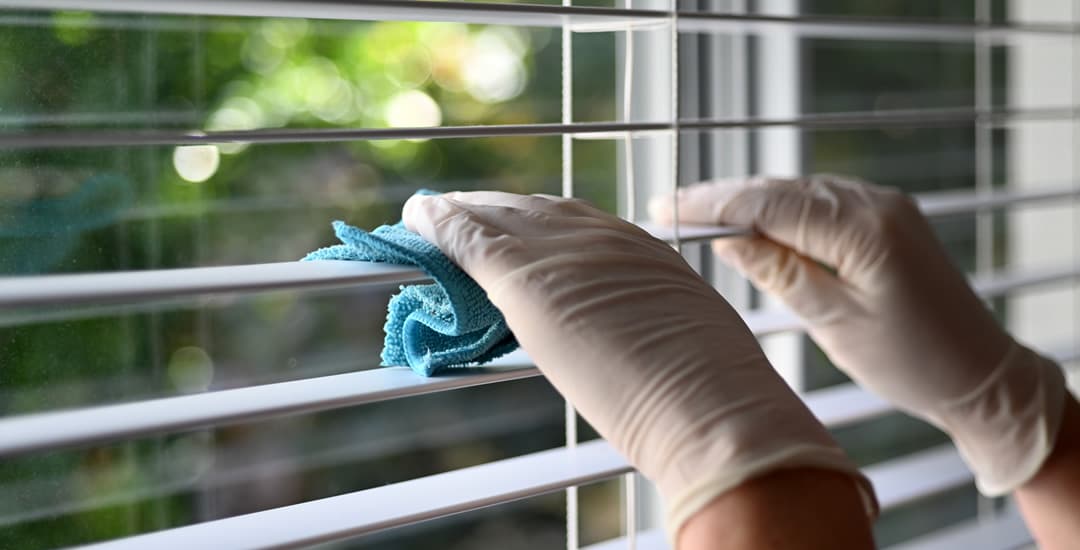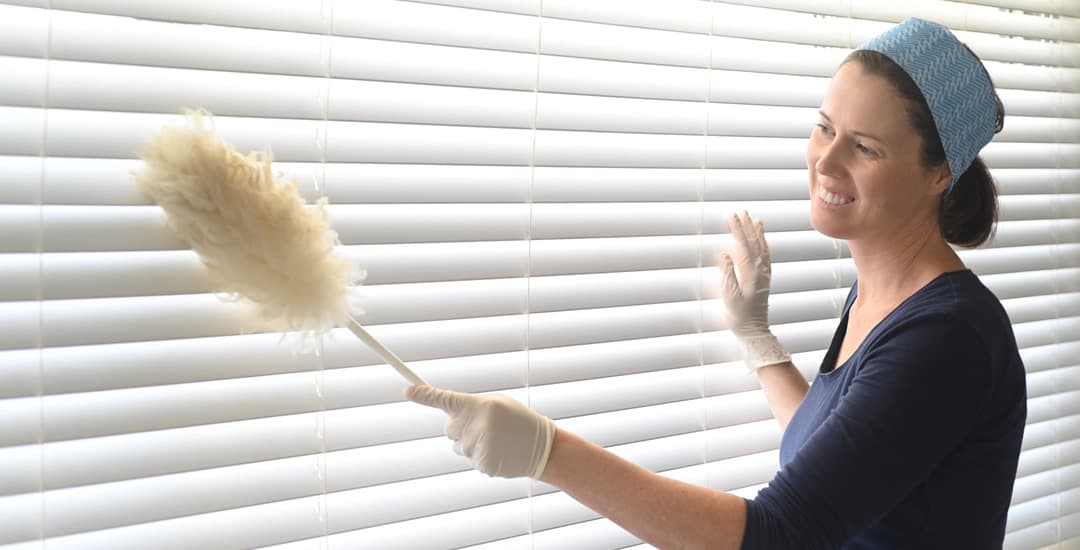
Are Venetian blinds easy to clean? Usually if you keep on top of things and dust them (or wipe them off for waterproof Venetians) every couple of weeks or so, then yes, this will be the work of minutes. You can also slow down or prevent dust from setting up camp on Venetian blinds in a meaningful way in the first place, just by opening and closing the blinds regularly.
If you’re considering buying Venetian blinds of any type and want to make sure you’re not inadvertently buying a decade or more of hassle in the cleaning stakes, read on to find out what’s involved in cleaning Venetian blinds, and how much of a hassle this is apt to become.
Related, I get emails fairly regularly from people asking either whether we sell Venetian blind cleaning tools/gadgets, or if we think Venetian blind brushes are worth the money; and so I’ll answer this question once and for all in this blog post as well (spoiler: don’t bother buying one).
What are Venetian blinds?
Right, what are Venetian blinds? The term “Venetian blind” refers to blinds that are made up of multiple horizontally lying slats, all held together by ladder tapes or cords.
They can be raised and lowered (i.e.., opened and closed) like any other type of blind, but you can also tilt their slats to more or less any angle of your choice. This allows you to filter light and deflect glare, or stop people outside from having a clear view inside without either leaving you sitting in darkness or losing your own view out of the window.
Venetian blinds can be made of aluminium, faux-wood, and real wood respectively (and even plastic in some cases, but really, urgh). Generally, if someone uses the term “Venetian blind” on its own rather than referring to it as a wooden or faux-wood blind, they’re talking about aluminium Venetian blinds specifically.
Guess where Venetian blinds originate from? WRONG! Ha ha. It’s actually Persia, or modern-day Iran. File that nugget of wisdom away for regurgitation in a pub quiz at some unspecified point in the future…
Are Venetian blinds easy to clean?
The reason that people tend to ask specifically “are Venetian blinds easy to clean” far more often than they do about any other type of blind, is because all of those horizontal slats – which are interrupted by ladder tapes or cords in at least two places and potentially more for longer blinds.
These multiple rows of narrow slats don’t half look fiddly when you think about how you’d clean them.
This is understandable. Something like a roller blind can just be washed off (assuming it is waterproof) or dusted over in seconds, but for Venetians, do you really have to dust or wash each slat individually to clean it? Really? Fair question, that does seem like a lot.
The answer to this is basically “sometimes/maybe,” but mostly, probably not. I’m really mangling my explanation here… Bear with me and I’ll try to make more sense in the next section.
How do you clean Venetian blinds as efficiently as possible?

Right. The first thing you need to know is that both aluminium Venetian blinds and faux-wood Venetian blinds are waterproof, while real wooden Venetian blinds are not; this will become relevant in a moment.
Generally, to clean Venetian blinds on a week-by-week basis or if you just do it regularly enough to keep on top of it, they need nothing more than dusting. You can use a duster cloth for this (an anti-static one) and this will take maybe a couple of minutes for a moderately sized blind.
However, just as effective and somewhat faster is to use a feather duster instead. Also, if you open and close the blind regularly and/or swivel the slats regularly, not much dust will build up on them in the first place.
Going back to my earlier point that aluminium Venetian blinds and faux-wood Venetian blinds are waterproof but that wooden Venetian blinds are not, this has a couple of implications.
The first of these is that faux-wood and aluminium Venetian blinds can be washed or wiped clean with a damp cloth, while wooden Venetian blinds can’t be made wet. However, as you can’t generally use a wooden blind (as it is not waterproof) in kitchens or bathrooms, where blinds do eventually tend to need washing, this is not normally an issue.
The same is true for the other two types of Venetians if used in “dry” rooms too.
This means that in “dry” rooms, for most homes, dusting is the most efficient way to clean Venetian blinds, with the odd potential exception such as if someone smokes in the room, or you have a solid fuel stove or open fire that creates a lot of ash or dust that won’t fully dust off, in which case the occasional wash will be warranted.
However, if your aluminium or faux-wood Venetian blind is used in a kitchen or bathroom, they will probably need a wash or wipe off now and then. The humidity or moisture in the air in both kitchens and bathrooms can cause dust to stick, which won’t always just breeze away with a dry duster.
Also, for blinds in kitchens, you need to factor in potential splattering with food, and if you fry stuff, oils and fats in the air further adding to the blind’s ability to glue dust down firmly.
Wiping or washing a Venetian blind then (of the types that can be washed) is a bit more time consuming than dusting, but also, needs to be performed far less often too; perhaps a couple of times a year when you get your major cleaning head on and muck in on everything in the house, so it’s not usually the end of the world.
Venetian blind slat sizes and how this affects cleaning times…
Getting into really geeky blinds territory here, Venetian blinds come with various different options for the width of each individual slat. Not all options are available for all types of Venetians, but the most common options are usually 25mm, 35mm, and 50mm respectively.
The narrower each slat, the more of them are required on the blind and so, the more time-consuming the blind will become to clean!
How long does it take to clean a Venetian blind?
This is a 100% unanswerable question, because it involves so many variables. The size of the blind, the width of the slats, your cleaning approach, how much coffee you’ve had… And so on.
But I will tell you that the fastest way to clean a Venetian blind that’s simply dusty (rather than gunky) is with a good quality (so fairly dense) feather duster. And not, as loud voiced, overly-confident presenters of 2am Freeview TV ads would have you believe… With a “Venetian blind cleaning gadget.”
And finally: Are Venetian blind cleaning tools any good?
Just to tie off if you have your heart set on a horizontally slatted blind but not on cleaning it, you may have seen a specially designed cleaning tool advertised for Venetian blinds that basically purports to dust/clean slatted blinds in a fraction of the time it takes dusting them by other methods.
These are usually called something like Venetian blind cleaners or Venetian blind duster brushes (and every variant thereof), and are shilled by general bits and bobs stores (like Home Bargains, BandM, Wilko and so on) and probably, the Amway catalogue, if that’s even still a thing.
If you take a second to Google them, you’ll see what they look like; I don’t feel that I can include a sample image of one here without risking getting sued, because my advice to you in terms of buying one is not to bother.
They’re not really effective at cleaning Venetian blinds of any type, regardless of which variant of the tool you buy (and man, if you have just been to Google, you may well wonder if half the GDP of China relies on the production of various different styles of them) it isn’t likely to be fit for purpose
The ones that have close-lying fingers may in fact move the dust along when in place, but are fiddly to get onto each set of slats, to the point that you’re highly likely to get bored and return to your traditional dusting approach well before the halfway point.
Also, as I mentioned earlier, blind slats come in various widths; which means that a generic tool like this won’t fit every blind. You may get lucky and find one that does, but you’re far more likely to get one that fits say, two slats then isn’t spaced correctly for the next couple.
Some of these tools only have three “fingers” to take care of just three rows of slats at once, which increases the chances of a fit; but also, increases the number of times you have to take the tool off and move it onto the next bit.
Also, remember that Venetian blinds are suspended by ladder tapes or cords… All Venetian blinds have at least two sets of cords or tapes, one on each of the blind, but not on the very ends.
This means that for each set of rows of slats you clean, you have to position the tool three times on a short blind. Many Venetian blinds have three, four, or five sets of ladder tapes or lift cords, to support greater widths; and require more positioning adjustments for each set of slat rows as a result.
You can’t just fiddle the tool onto one side of the blind and sweep it cleanly along all the way to the other!
Do Venetian blind cleaning brushes work?
No! Not in my opinion, that of my email in box, nor multiple experiments on slow days in the R&D workshop. Ultimately, Venetian blind cleaning brushes won’t effectively remove dust from Venetian blinds, and will take you way longer to use than dusting the slats with a feather duster or dusting cloth.
Also, when these Venetian blinds cleaners do get coated in dust, this tends to not just bash off like it will on a feather duster if you take it outside and shake it, and there’s no way to wash them; so they become effectively useless even if they do work initially on the first section of slats, or may even begin to smear dust or dirt back onto your blind in short order!
Venetian blind cleaning tools don’t work… If they did, we’d absolutely sell them, the markup on these things has to be outrageous given what they are versus how much they’re commonly sold for!
I’m also kind of mad at them because the way they’re marketed is designed to make you as their target buyer believe that cleaning a Venetian blind is such a hard and time-consuming task in the first place that it is virtually insufferable without a tool.
In fact, I strongly suspect that a reasonable number of you only got here in the first place due an ad for a Venetian blind dusting tool subliminally leading you to believe that cleaning a Venetian blind would generally take ages or be hard work.
Is that the case? If you’ve bought and had a go with one of these slat dusters, I’d be interested to hear how you got on, so tell me in the comments.
I’m particularly interested to hear if any of my readers actually rate Venetian blind cleaning gadgets and find them effective/efficient… Please note, I will check submissions for email addresses such as ReputationManagent@VenetianBlindCleaningTool.com before publication…
Thank you for reading!




